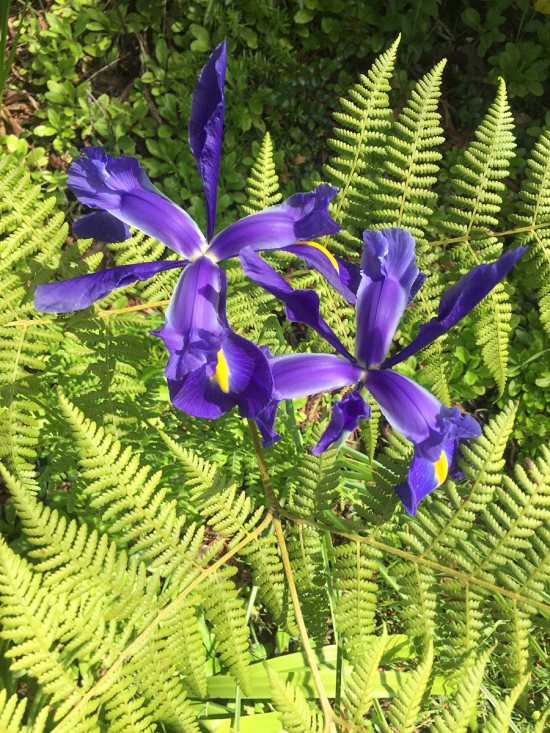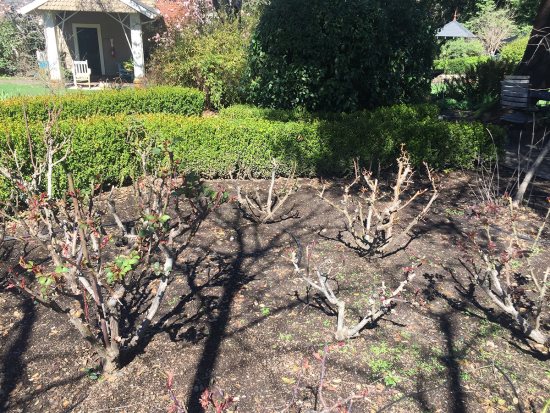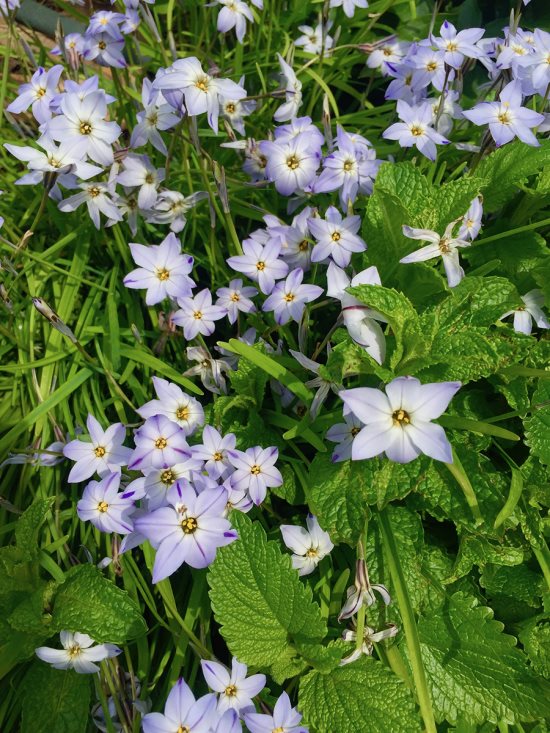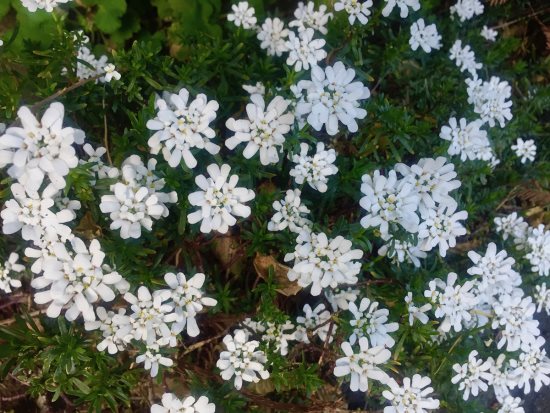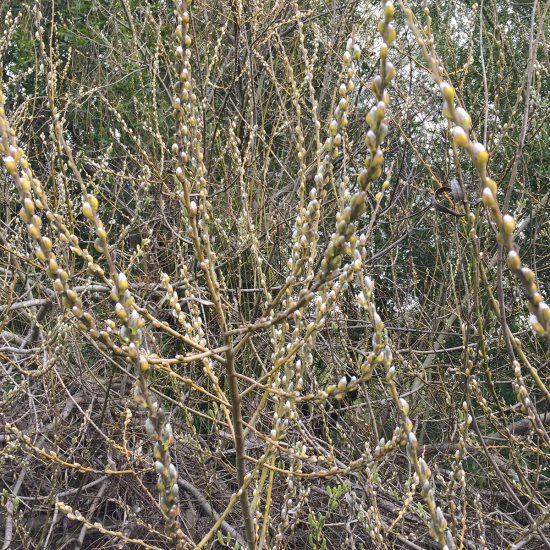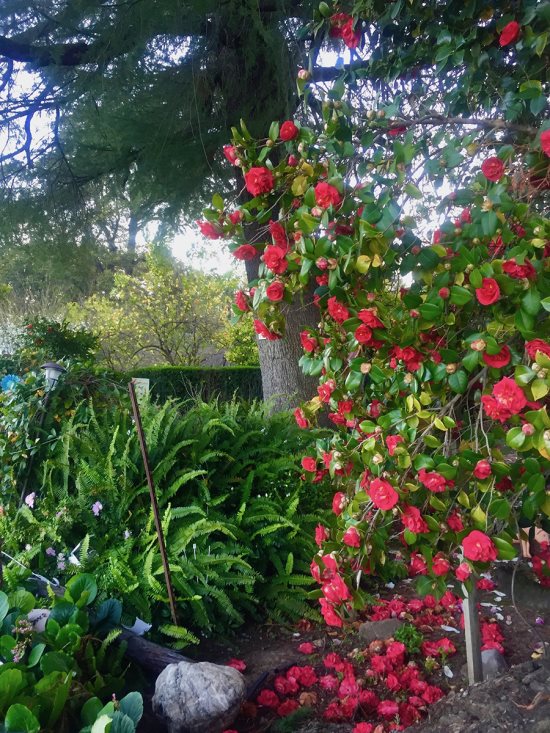 |
|
|
Under a redwood tree, acid-loving plants flourish including ferns, azaleas, camellias, and rhododendrons. Photos Cynthia Brian
|
|
|
|
|
|
"Look for helpers. You will always find those who are helping." - Mister Rogers
 After sowing seeds of beets, arugula, Swiss chard and leeks, I sat on my small white wooden bench to watch. Within minutes a black and white king snake slithered by my foot sending shivers up my spine at the sudden surprise yet joy because I know that king snakes keep rattlers away. A tailless baby lizard scampered to a rock to bask in the sunshine, and a chorus of frogs croaked their mating calls, each attempting to outdo the other. Two moths flitted through the nasturtiums, a swarm of honeybees gathered on the rosemary, and a clew of worms tilled the rich soil. A covey of quail called to one another, landing in my chestnut tree. My vegetable garden was alive with congenial visiting helpers.
After sowing seeds of beets, arugula, Swiss chard and leeks, I sat on my small white wooden bench to watch. Within minutes a black and white king snake slithered by my foot sending shivers up my spine at the sudden surprise yet joy because I know that king snakes keep rattlers away. A tailless baby lizard scampered to a rock to bask in the sunshine, and a chorus of frogs croaked their mating calls, each attempting to outdo the other. Two moths flitted through the nasturtiums, a swarm of honeybees gathered on the rosemary, and a clew of worms tilled the rich soil. A covey of quail called to one another, landing in my chestnut tree. My vegetable garden was alive with congenial visiting helpers.
 For years Fred Rogers modeled the benefits of caring on his award-winning children's program, "Mister Rogers Neighborhood." The root principle of his teachings was to be a good neighbor and find helpers. Having friendly, helpful neighbors is good not only for humans but for plants and animals, too. We are all interdependent on one another for survival. To fully understand how important buddies are, we need to look no further than the kingdom of plants.
For years Fred Rogers modeled the benefits of caring on his award-winning children's program, "Mister Rogers Neighborhood." The root principle of his teachings was to be a good neighbor and find helpers. Having friendly, helpful neighbors is good not only for humans but for plants and animals, too. We are all interdependent on one another for survival. To fully understand how important buddies are, we need to look no further than the kingdom of plants.
 In gardening, we call this companion planting. Health and yields are improved when certain plants are grown together. Some plants will attract beneficial insects while others will repel destructive ones. Certain flowers, vegetables, and herbs grown together will produce more beautiful flowers and flavorful edibles than if grown in solitary confinement.
In gardening, we call this companion planting. Health and yields are improved when certain plants are grown together. Some plants will attract beneficial insects while others will repel destructive ones. Certain flowers, vegetables, and herbs grown together will produce more beautiful flowers and flavorful edibles than if grown in solitary confinement.
 When planning your companion garden, for the team to thrive, it is important to consider these critical requirements. Determine if they enjoy the same type of soil (sandy, loamy, clay, silty, peaty), light exposure (shade, partial shade, full sun, partial sun), water (how much and how often), and pest control.
When planning your companion garden, for the team to thrive, it is important to consider these critical requirements. Determine if they enjoy the same type of soil (sandy, loamy, clay, silty, peaty), light exposure (shade, partial shade, full sun, partial sun), water (how much and how often), and pest control.
 Soil: The ideal garden soil is loam as it is a balanced mixture of sand, silt, and clay with plenty of humus. To improve our clay soil, we need to improve the drainage and lighten the heaviness by adding copious amounts of organic matter. A combination of compost, mulch, and cover crops will enrich the soil, prevent erosion and minimize weed growth. ... continued from Page D12
Soil: The ideal garden soil is loam as it is a balanced mixture of sand, silt, and clay with plenty of humus. To improve our clay soil, we need to improve the drainage and lighten the heaviness by adding copious amounts of organic matter. A combination of compost, mulch, and cover crops will enrich the soil, prevent erosion and minimize weed growth. ... continued from Page D12

 Light: Record where the sun is during different times of the day. Remember that tall plants will provide shade for smaller plants that need protection.
Light: Record where the sun is during different times of the day. Remember that tall plants will provide shade for smaller plants that need protection.
 Water: Roots need oxygen to survive. Waterlogged roots rot. Vegetables require about one inch of water a week, columbines prefer a moist environment, while succulents succeed in drier soils. Determine your own watering personality then choose compatible plants accordingly.
Water: Roots need oxygen to survive. Waterlogged roots rot. Vegetables require about one inch of water a week, columbines prefer a moist environment, while succulents succeed in drier soils. Determine your own watering personality then choose compatible plants accordingly.
 Pest Control: One of the most exciting things about companion planting is how various plants can attract good bugs and deter the bad ones when surrounded by their friends. Alliums are terrific company for almost all plants except asparagus and beans!
Pest Control: One of the most exciting things about companion planting is how various plants can attract good bugs and deter the bad ones when surrounded by their friends. Alliums are terrific company for almost all plants except asparagus and beans!
 When building your garden, think about building a community of friends.
When building your garden, think about building a community of friends.
 Roses are jewels of the garden for at least three seasons, and, as with their mineral cousins, their beauty is enhanced when placed in the right setting. According to rose expert Michael Marriott, senior rosarian and technical manager of David Austin Roses Ltd. in Albrighton, England, roses are beautifully suited to mixed garden borders. The trick to combining roses successfully with other garden plants lies in knowing which will play well together. Although we don't normally plant roses with our vegetables, rose petals are edible. Gathered early in the morning, they make a tasty topping for salads and soups.
Roses are jewels of the garden for at least three seasons, and, as with their mineral cousins, their beauty is enhanced when placed in the right setting. According to rose expert Michael Marriott, senior rosarian and technical manager of David Austin Roses Ltd. in Albrighton, England, roses are beautifully suited to mixed garden borders. The trick to combining roses successfully with other garden plants lies in knowing which will play well together. Although we don't normally plant roses with our vegetables, rose petals are edible. Gathered early in the morning, they make a tasty topping for salads and soups.
 Favorite Blue Perennials:
Favorite Blue Perennials:
 Lavender
Lavender
 Blue Eyed Grass
Blue Eyed Grass
 Monkshood
Monkshood
 Aster
Aster
 Bellflower
Bellflower
 Cornflower
Cornflower
 Delphinium
Delphinium
 Sea holly
Sea holly
 Geranium
Geranium
 Salvia
Salvia
 Pincushion flower
Pincushion flower
 Veronica
Veronica
 Viola
Viola
 Favorite Other Colored Perennials:
Favorite Other Colored Perennials:
 Agastache
Agastache
 Candytuft
Candytuft
 Chamomile
Chamomile
 Columbine
Columbine
 Penstemon
Penstemon
 Black-eyed Susan
Black-eyed Susan
 Sedum
Sedum
 Verbena
Verbena
 Favorite Biennial
Favorite Biennial
 Foxglove
Foxglove
 Favorite Annuals
Favorite Annuals
 Cosmos
Cosmos
 Nicotiana
Nicotiana
 Nigella
Nigella
 Poppy
Poppy
 Sweet pea
Sweet pea
 Favorite Hedge
Favorite Hedge
 Boxwoods
Boxwoods
 The best partners, he says, bloom exactly together or closely overlap. "The joy is in pairing flowers that play off one another when seen side by side in full bloom. The goal is to heighten peak bloom experiences. Extending the bloom season is a different exercise.
The best partners, he says, bloom exactly together or closely overlap. "The joy is in pairing flowers that play off one another when seen side by side in full bloom. The goal is to heighten peak bloom experiences. Extending the bloom season is a different exercise.
 Here is a short list of his recommended rose partners.
Here is a short list of his recommended rose partners.
 When it comes to vegetable companions, we have a long list of allies and enemies. General rules advise avoiding planting in long rows or big patches to deter the pests. Instead, interplant with flowers and herbs to confuse the predators and attract the beneficials.
When it comes to vegetable companions, we have a long list of allies and enemies. General rules advise avoiding planting in long rows or big patches to deter the pests. Instead, interplant with flowers and herbs to confuse the predators and attract the beneficials.
 Marigolds are the workhorse of any vegetable planting as they discourage beetles and nematodes. The presence of calendula in any garden is a plus repelling nasty insects while the roots clean the soil by establishing active relationships with soil-borne fungi. Nasturtium, chives and garlic keep away aphids. Dill improves growth and flavor in all plants of the cabbage family including kale while mint will deter ants and cabbage moth and improve the flavor of peas. However, dill will retard the growth of your carrots. Parsley, carrots and parsnip attract praying mantis, ladybugs and spiders that dine on pests. Beans, peas and clover make nitrogen that enrich the soil.
Marigolds are the workhorse of any vegetable planting as they discourage beetles and nematodes. The presence of calendula in any garden is a plus repelling nasty insects while the roots clean the soil by establishing active relationships with soil-borne fungi. Nasturtium, chives and garlic keep away aphids. Dill improves growth and flavor in all plants of the cabbage family including kale while mint will deter ants and cabbage moth and improve the flavor of peas. However, dill will retard the growth of your carrots. Parsley, carrots and parsnip attract praying mantis, ladybugs and spiders that dine on pests. Beans, peas and clover make nitrogen that enrich the soil.
 Never plant corn and tomatoes near one another as the identical worm attacks both. If you want potatoes, plant horseradish in the four corners as protection and refrain from including squash, cucumbers or sunflowers in the same location as they all suffer from the same blight. If you are growing strawberries, prevent worms by creating a border of thyme and strengthen resistance to disease and insects with borage. Oregano provides general pest protection while basil ward offs flies and mosquitoes while improving (no surprise) the flavor and growth of tomatoes.
Never plant corn and tomatoes near one another as the identical worm attacks both. If you want potatoes, plant horseradish in the four corners as protection and refrain from including squash, cucumbers or sunflowers in the same location as they all suffer from the same blight. If you are growing strawberries, prevent worms by creating a border of thyme and strengthen resistance to disease and insects with borage. Oregano provides general pest protection while basil ward offs flies and mosquitoes while improving (no surprise) the flavor and growth of tomatoes.
 Before you start your spring planting, consider the community you will be creating. The rains are continuing, the crabapples are blooming, and the willow buds are set to burst.
Before you start your spring planting, consider the community you will be creating. The rains are continuing, the crabapples are blooming, and the willow buds are set to burst.
 Fred Rogers said that maybe heaven is the connections we make while on earth. In gardening as in life, it takes a village.
Fred Rogers said that maybe heaven is the connections we make while on earth. In gardening as in life, it takes a village.
 Happy Gardening. Happy Growing.
Happy Gardening. Happy Growing.
|

